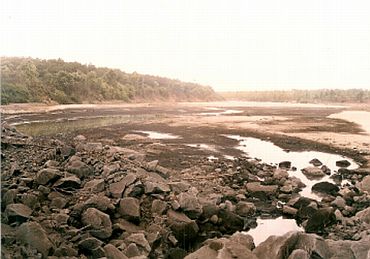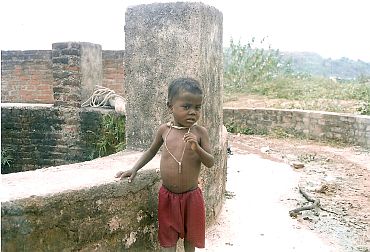The degeneration of the health conditions of the people, especially tribal women and children, and water contamination are some of the most serious impacts of coal mining in Jharkhand, notes Nitish Priyadarshi.
Jharkhand is an area of abundant coalmines. Most of the coalmines are situated in Hazaribag, Chatra, Palamau, Rajmahal, Dhanbad and Ranchi districts. The mighty Damodar river and its tributaries flow through these coalmines.
Jharkhand is the homeland of over a dozen indigenous communities, the major ones being the Santhals, the Mundas, the Oraons and the Hos. Most of their population is concentrated around the coalmines area.
Today, the picture of Damodar river, considered sacred by the local tribals, is quite like a sewage canal shrunken and filled with filth, emanating obnoxious odours.
This river, once known as 'river of sorrow' for its seasonal ravages, has now turned into a 'river of agony' from the environmental perspective.
The author is a geologist, and lecturer in the Department of Environment and Water Management, Ranchi University.
Please ..
Water sources have been acutely contaminated
Image: Discharge of uncontrolled industrial wastewater is the major source of pollution of Damodar riverDue to extensive coal mining and vigorous growth of industries in this area, water resources have been badly contaminated. The habitants have, however, been compromising by taking contaminated and sometimes polluted water, as there is no alternative source of safe drinking water. Thus, a sizeable populace suffers from water-borne diseases.
The Damodar river basin is a repository of approximately 46 per cent of the Indian coal reserves. A high demographic and industrial expansion has taken place in last three decades in the region.
Exploitation of coal by underground and open cast mining has lead to a great environmental threat in this area.
Besides mining, coal based industries like coal washeries, coke oven plants, coal fired thermal power plants, steel plants and other related industries in the region also greatly impart towards degradation of the environmental equality vis-a-vis human health.
The most affected part of the natural resources is water in this region and thereby it takes a direct toll on human health.
Due to easy availability of coal and prime cooking coal, several thermal power plants, steel plants have grown up. Discharge of uncontrolled and untreated industrial wastewater, often containing highly toxic metals, is the major source of pollution of Damodar river.
Mine water and runoff through overburden material of open cast mines also contribute towards pollution of nearby water resources of the area.
Huge amount of overburden materials have been dumped on the bank of the river and its tributaries, which finally spreads in the rivers especially in the rainy season. These activities have resulted in the visible deterioration of the quality of the river water.
The large scale mining operations going on this region have also adversely affected ground water table in many areas with the result that yield of water from the wells of adjoining villages has drastically reduced.
Further, effluents discharged from the mine sites have also seriously polluted the underground water of the area.
Mine water is generally bacterially contaminated which is clear from the value lying in the range of 100 to 2500. Heavy metals like manganese, chromium, lead, arsenic, mercury, floride, cadmium, and copper are also found in the sediments and water of the Damodar river and its tributaries like the Safi.
As per the heath survey of the local people, the most common diseases are dysentery, diarrhea, skin infection, worm infection, jaundice, and typhoid. Dysentery and skin infections also occur in high percentage in the area.
'They are not very confident about their life span'
Image: Many, especially children of the coal fields, suffer from dysentery and diarrhea due to contaminated drinking water in the areaThe Agaria tribe and other tribes that inhabit the coalfields of North Karanpura and East Parej are faced with severe water contamination.
In East Parej, more than 80 per cent of the community lives in poverty. Water for the community comes from hand pumps, dug wells, local streams and rivers.
In some areas, mine water and river water is supplied through pipes. But most people are dependent on other sources -- which are contaminated -- for their water needs.
Women and children in these areas have to travel more than 1 kilometer to fetch safe drinking water. Most villagers are left with no choice but to drink contaminated water.
Dug wells are generally dried up during the summer and winter seasons. Natural drainage is obstructed and diverted due to the expansion of mining. Villagers in these areas have no concept of how to preserve and purify rainwater.
"Our longevity has reduced drastically," said Phulmani Kujur, a 38 year-old women of East Parej coal field.
"We avoid taking bath everyday, there is a gap of 5 to 10 days, and do not drink water adequately due to water pollution," said Mahesh, another villager.
Study reveals that average longevity of women in East Parej coal field was found to be 45 and in most of the villages only one or two women had crossed the age of 60.
In North Karanpura coal field, the average longevity of male is 50 years and that of female is 45 years.
On top of it, malaria is very common here. It is found that there are numerous ditches, stagnant mine water, and open tanks breeding all the species of mosquitoes. Majority of the deaths are attributed to malaria.
Next comes skin diseases such as eczema, rashes etc. It may be due to lack of care and cleanliness or due to the presence of nickel in drinking water. In some area like East Parej, high nickel (0.024 mg/l) have been reported in the water. According to the World Health Organisation, nickel is a common skin allergen.
Many, especially children of the coal fields, suffer from dysentery and diarrhea. According to the residents of the coal field, it is because of consuming contaminated water.
About 60 per cent of the local people are affected with seasonal allergies. Other diseases found were tuberculosis, headache, joints pain (pain begins at the age of 5 to 10 years, especially in North Karanpura), gastric, cough and cold and asthma.
When asked from the villagers in East Parej and North Karanpura about what do they think about their future, they replied that the situation is going to worsen. They are not very confident about their life span.
Fluoride, arsenic, nickel, sulfate, and manganese pose the biggest threats to water sources in the region. They have been shown to cause adverse effects when consumed over a long period of time.
Health care facilities can improve the situation immensely, but it is more desirable to maintain the philosophy that prevention is better than the cure.
Medical checkups can be adopted to improve the situation. Installation of pollution control equipments are needed for monitoring and analysing pollution data.
Seeing that nearly all the water sources under study are contaminated, the only short-term solution for safe drinking water is rain water harvesting.
Indigenous and cost effective methods, such as disinfecting and purifying water with the help of medicinal plants, can also be adopted for purifying water.




article